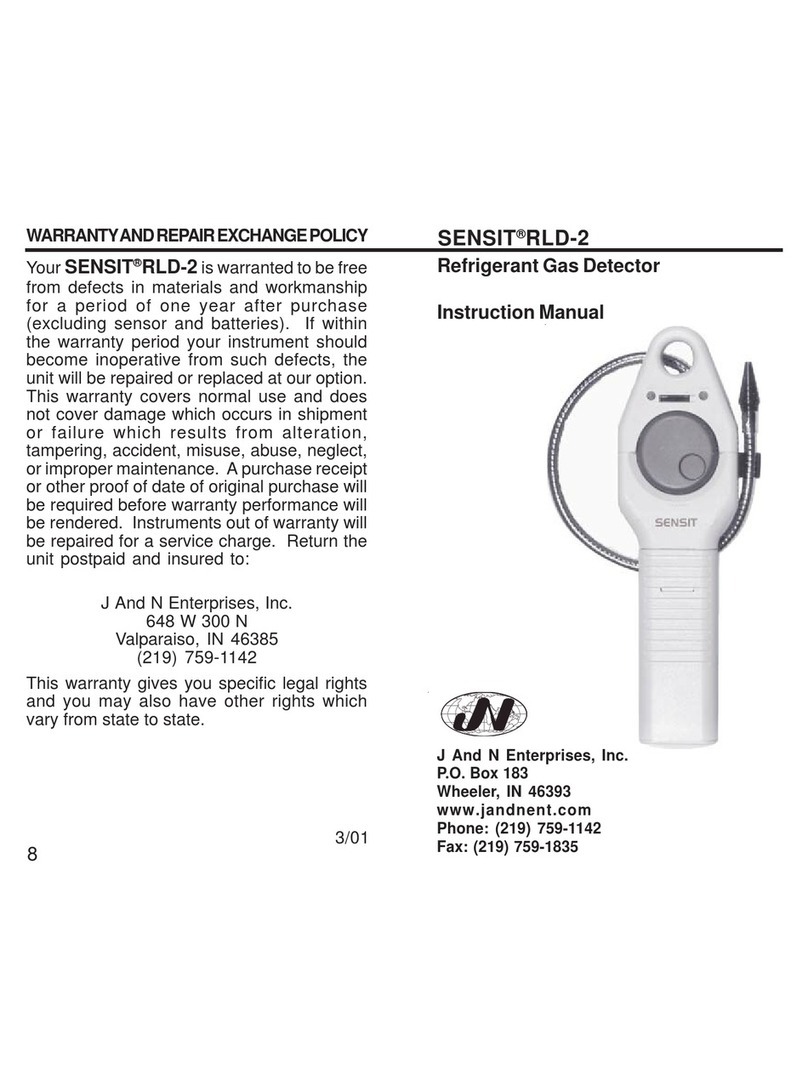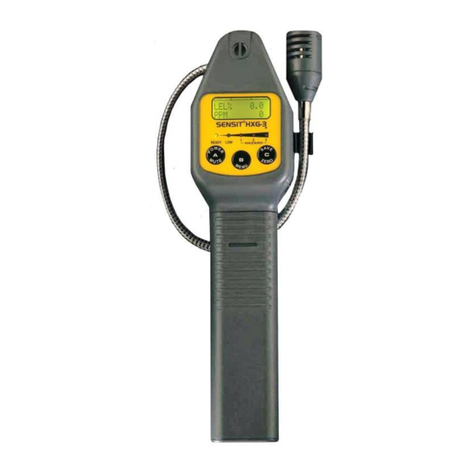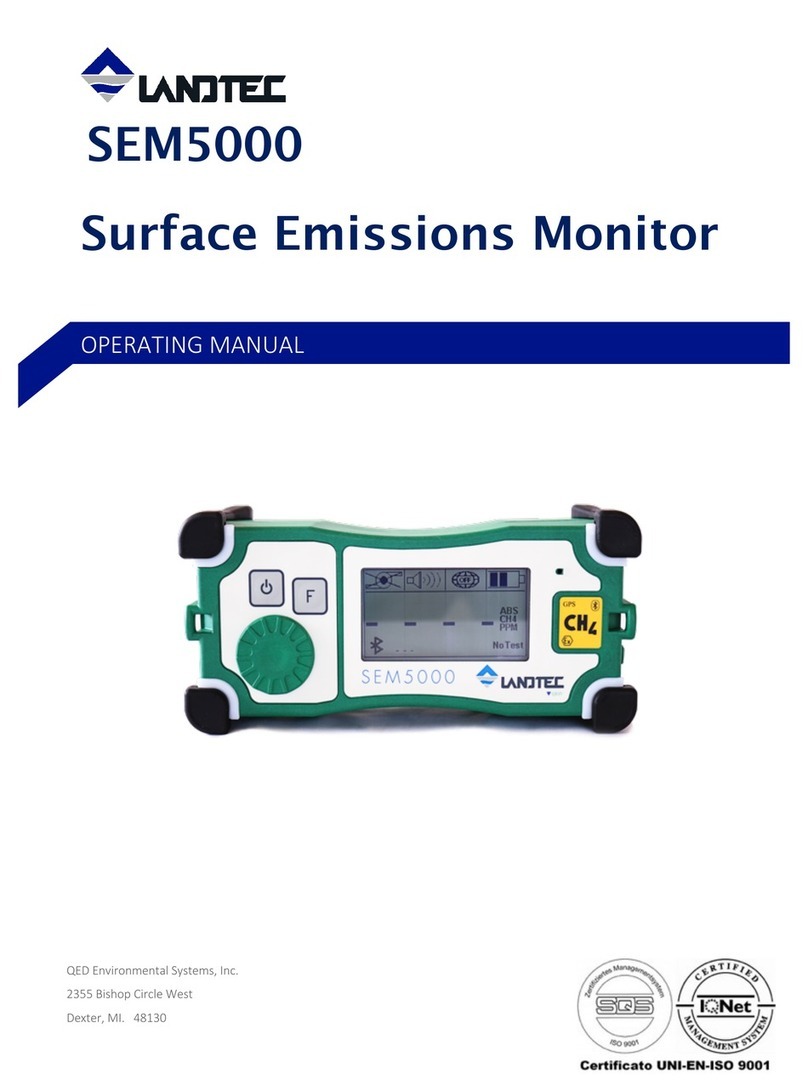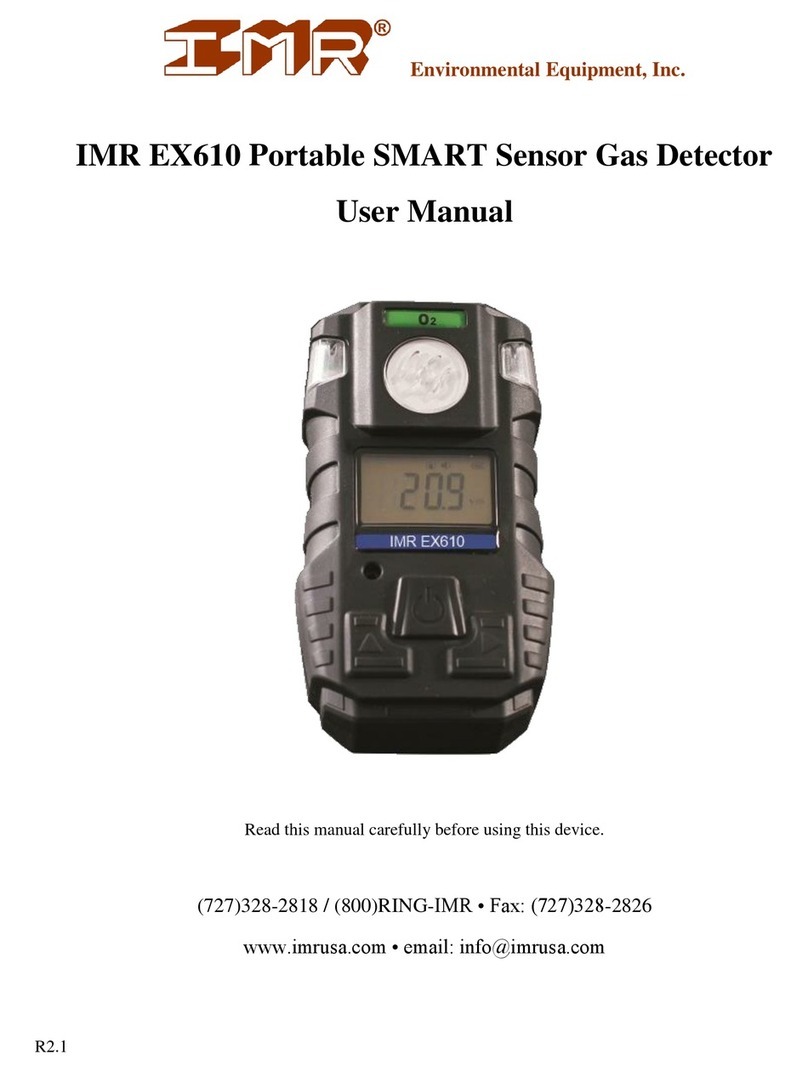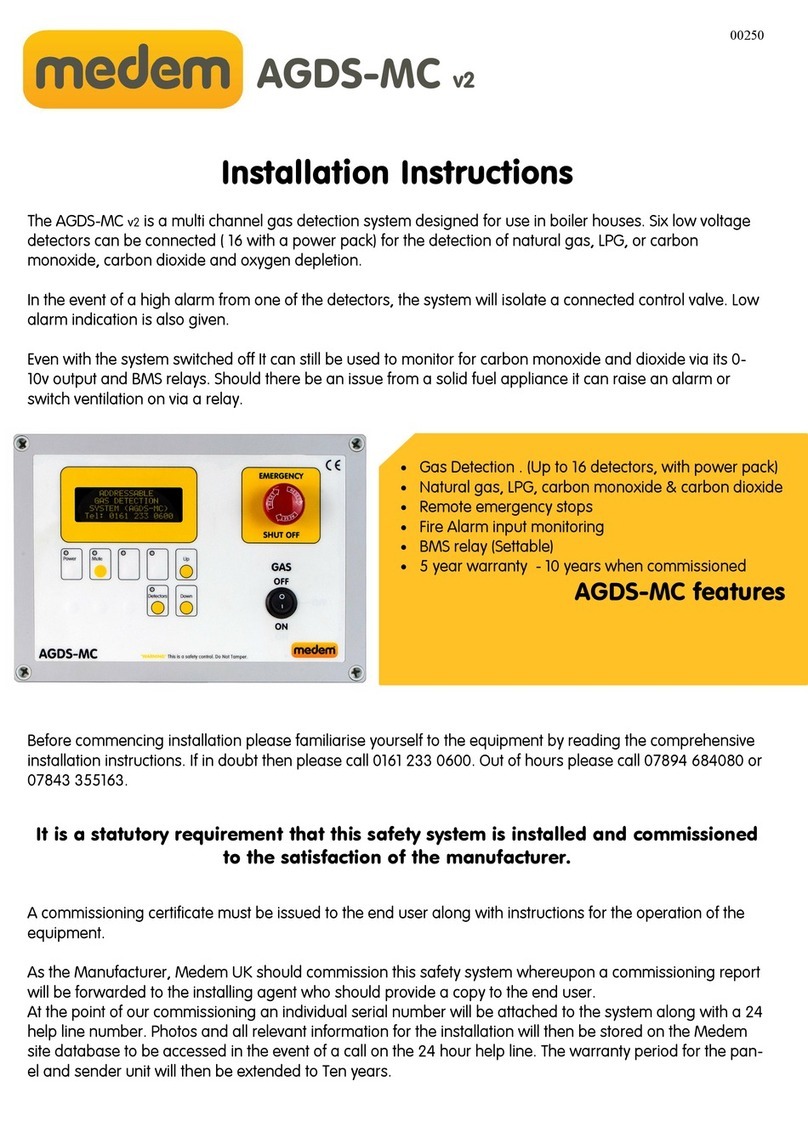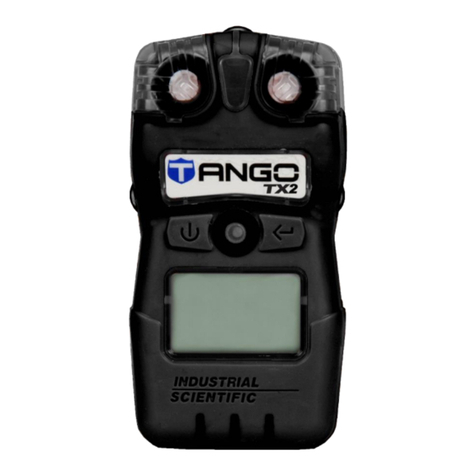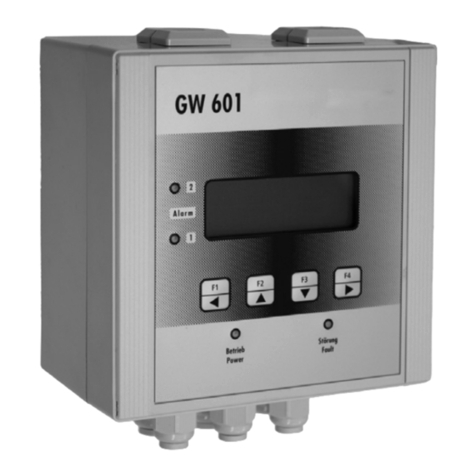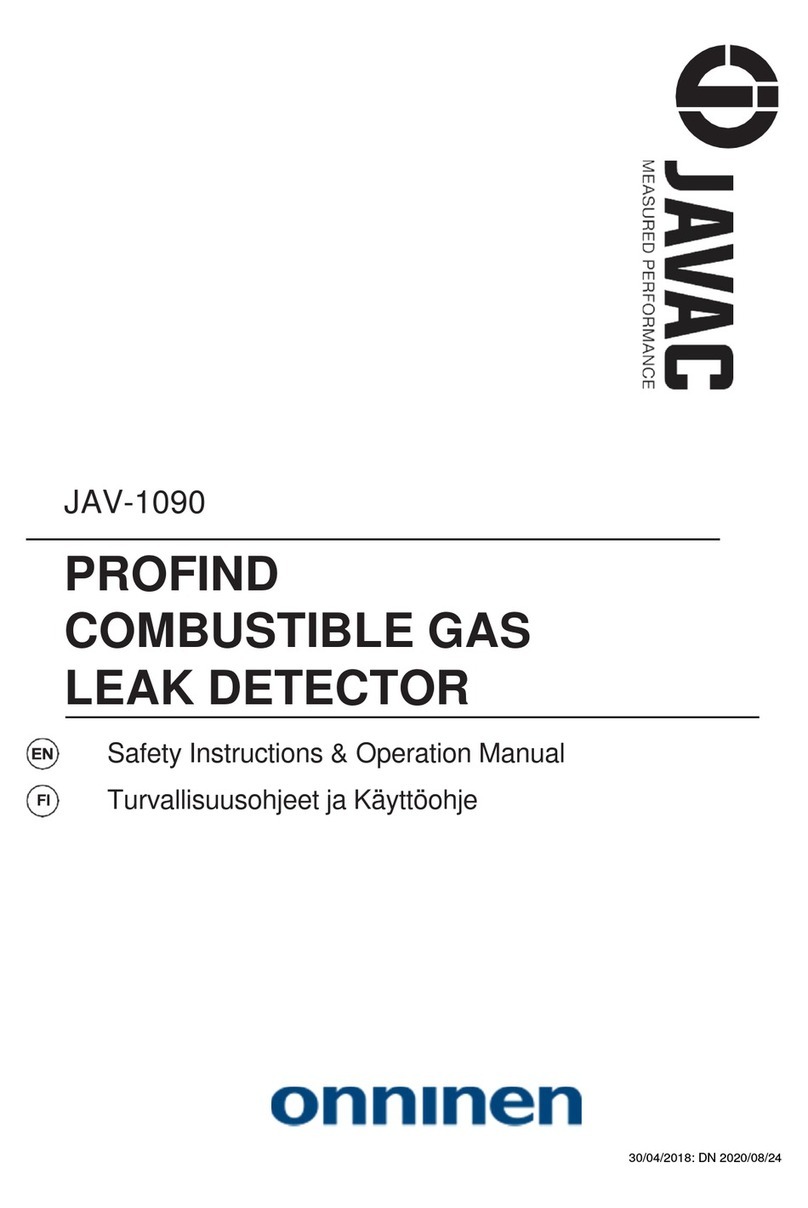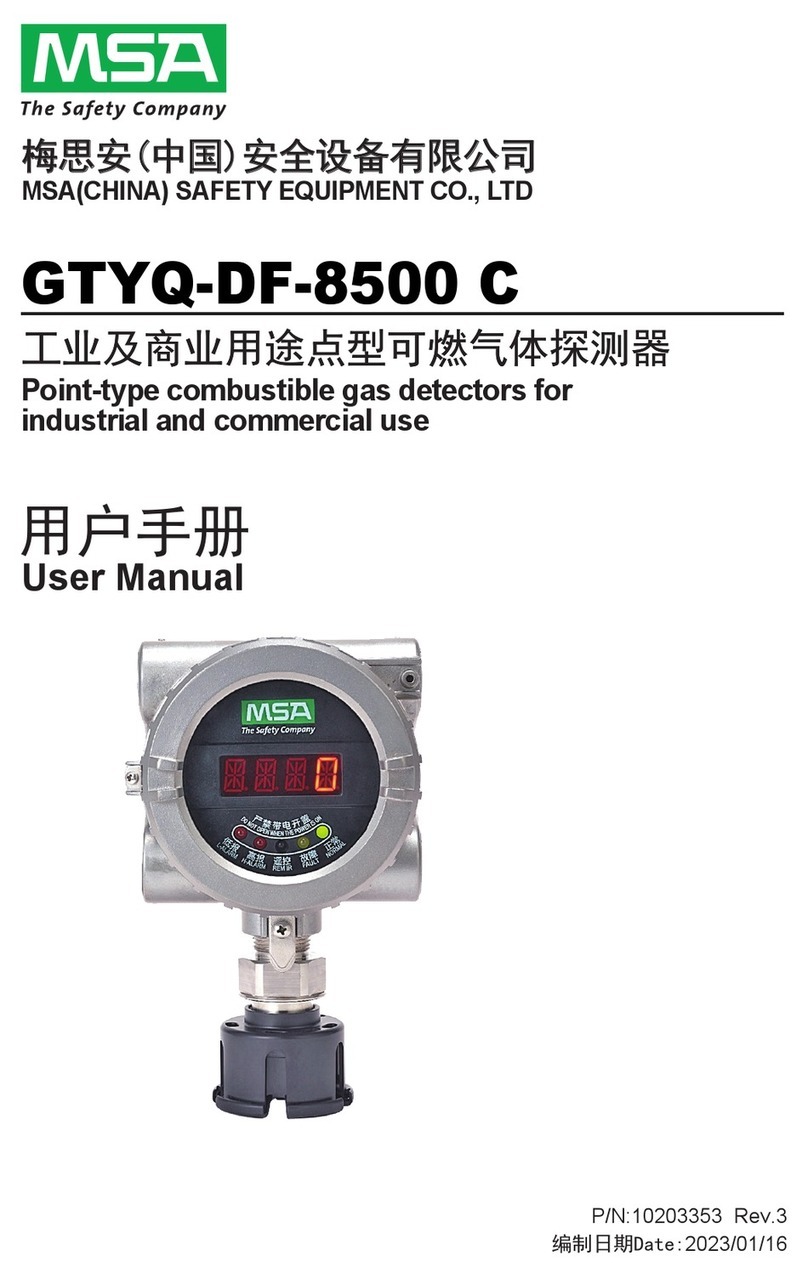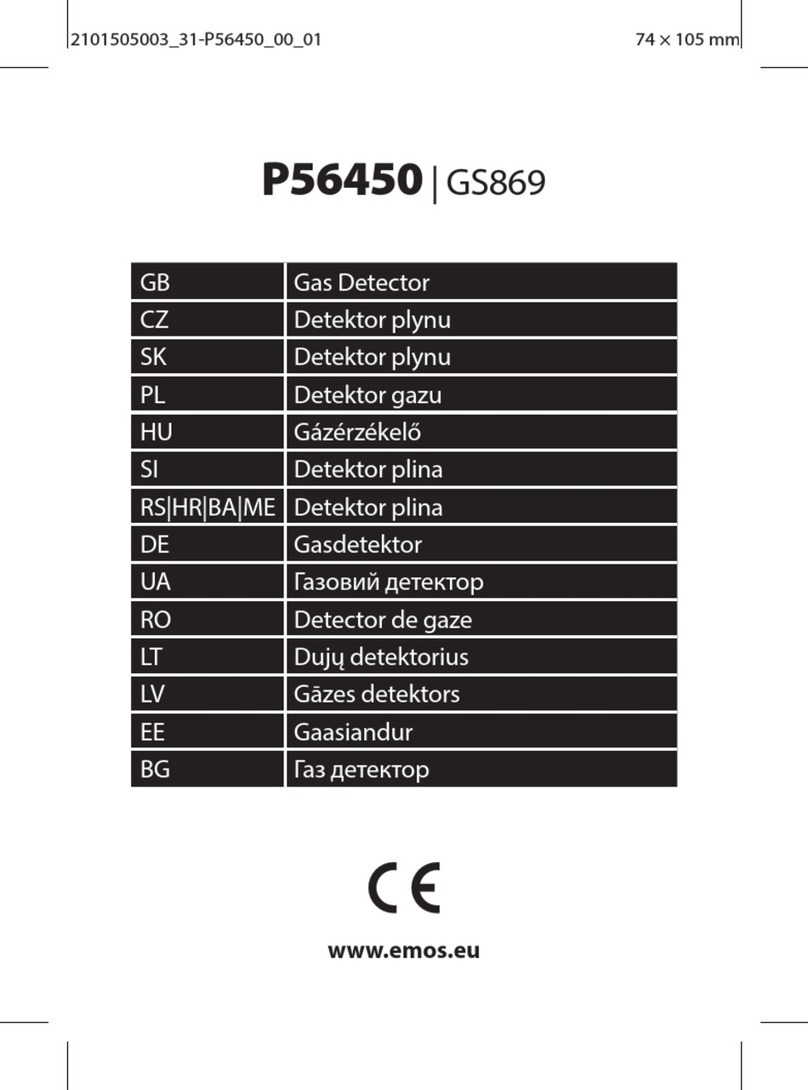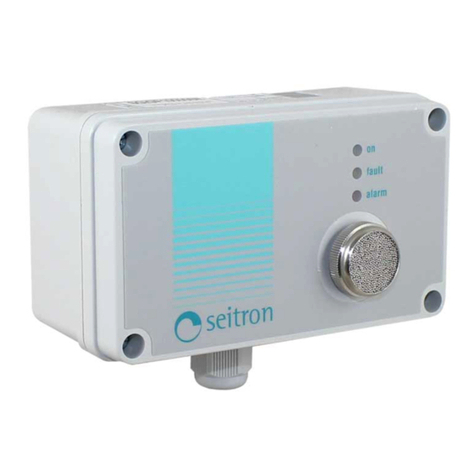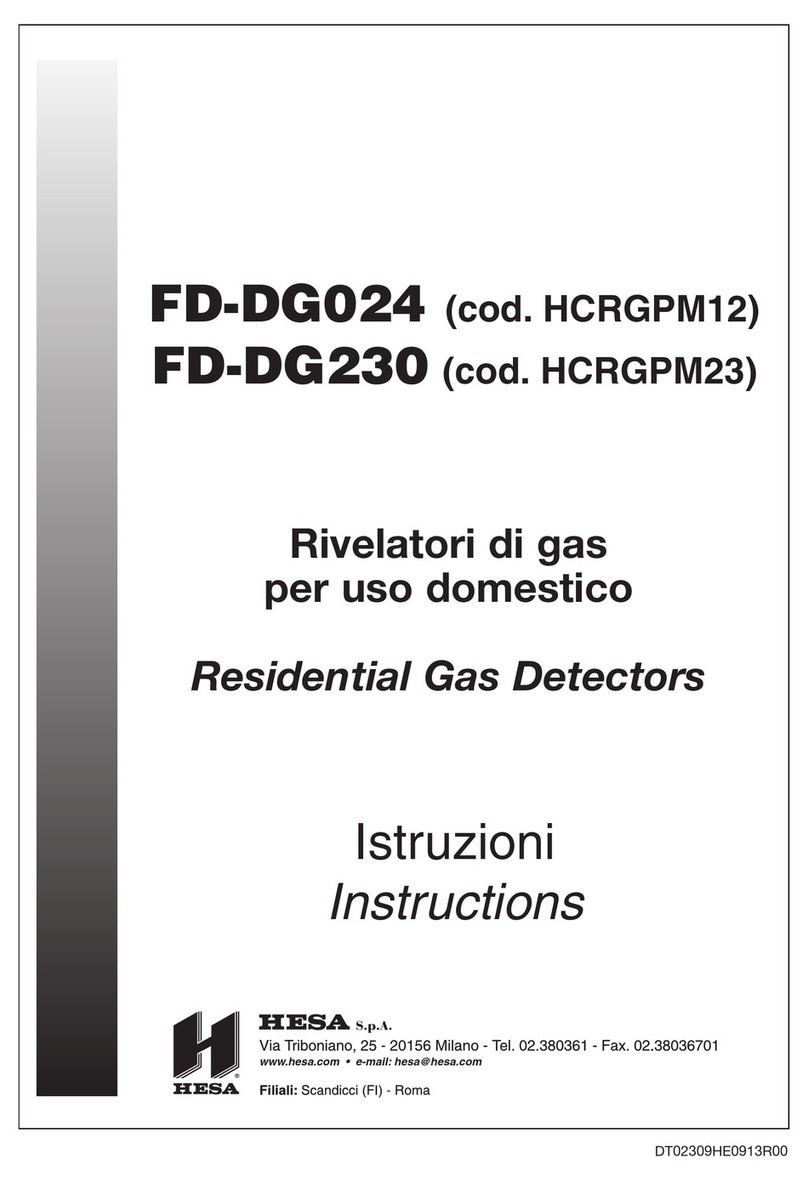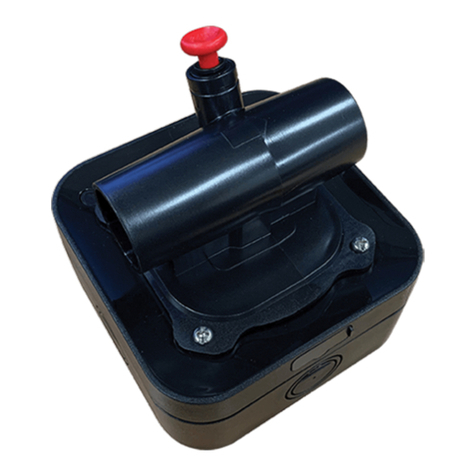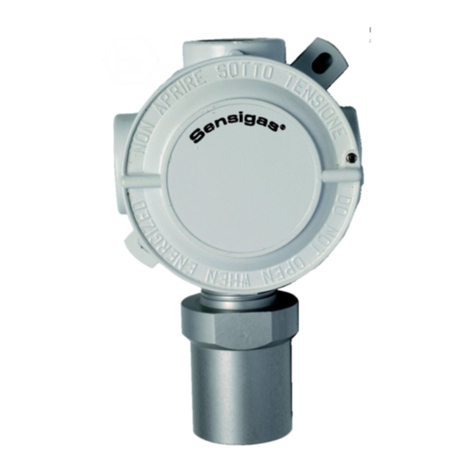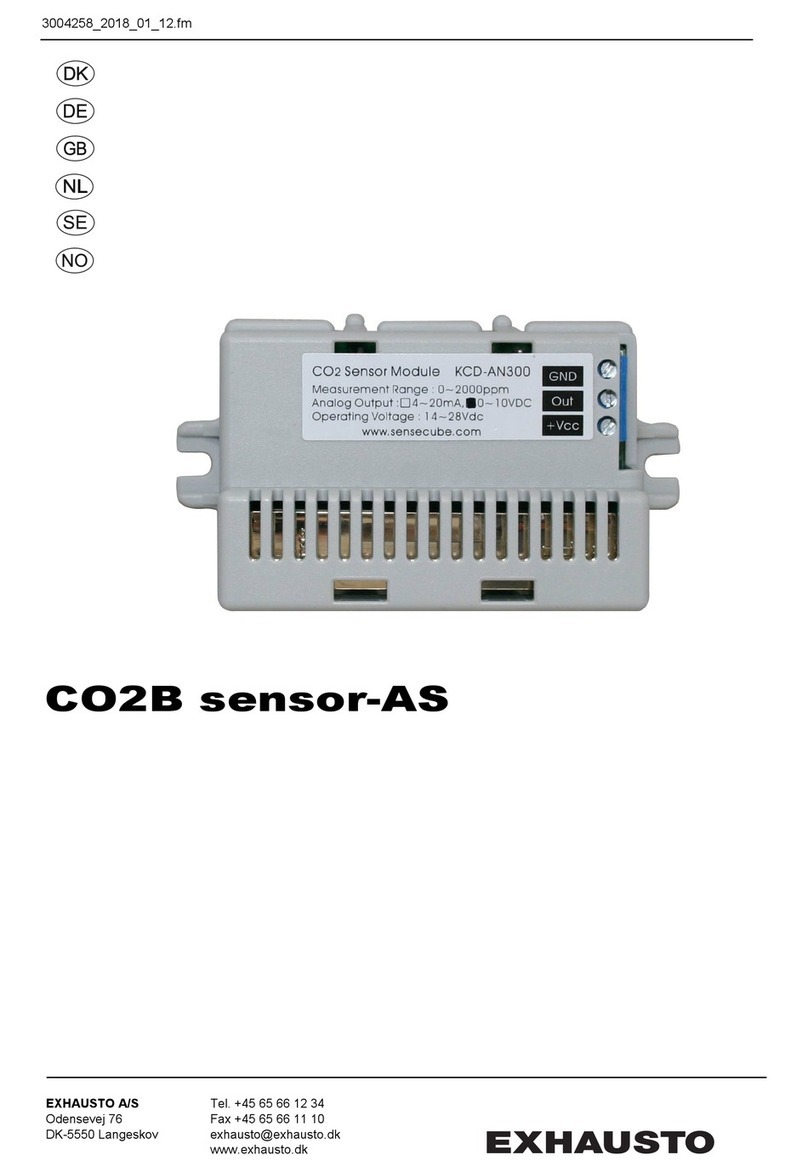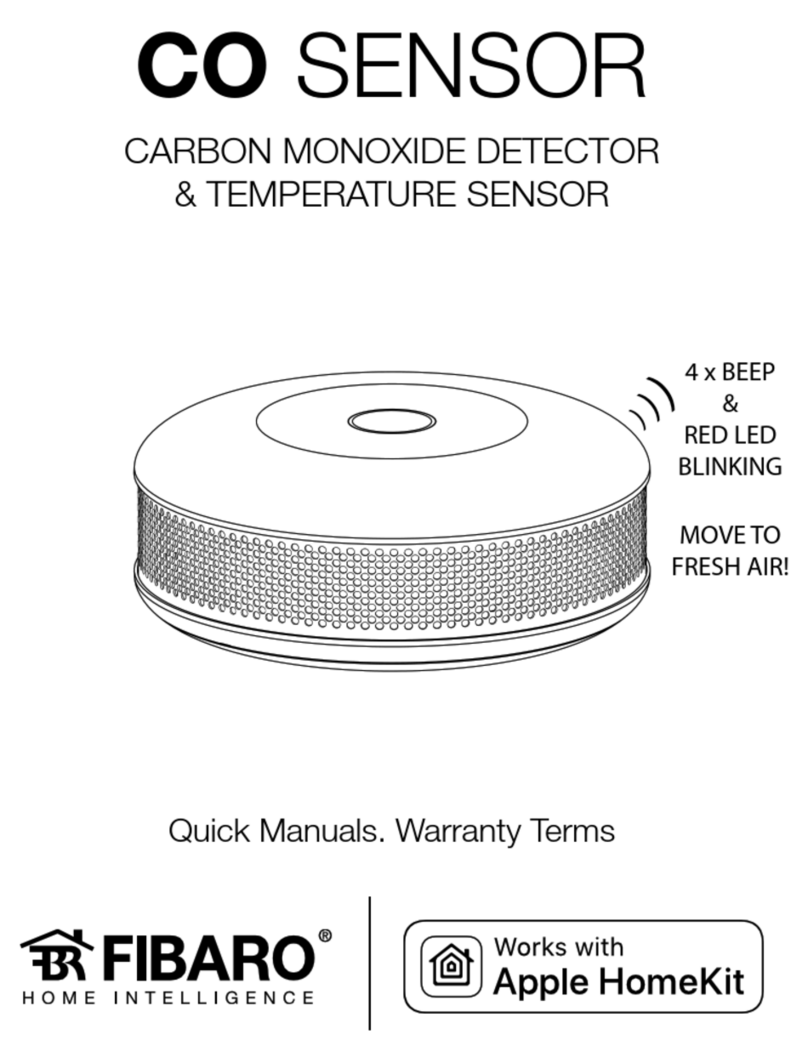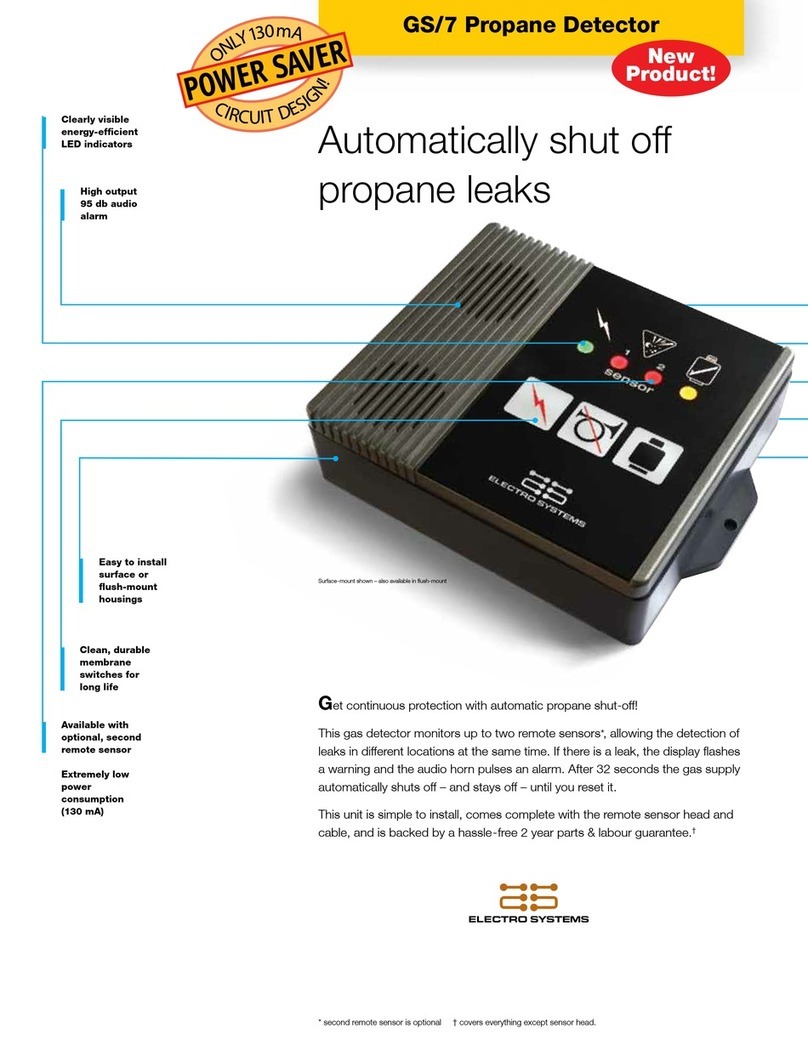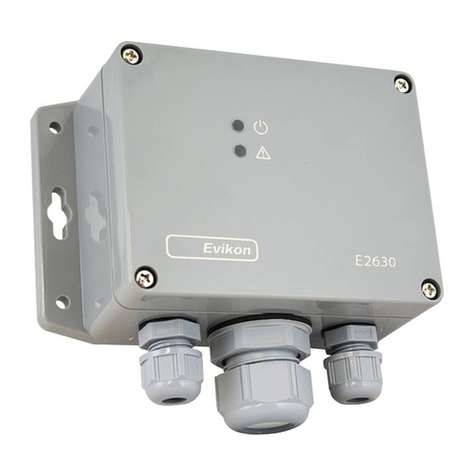Sensit GOLD G3 User manual

851 Transport Drive • Valparaiso, IN 46383 (USA)
Phone: 219.465.2700 • www.gasleaksensors.com
INSTRUCTION MANUAL
Read and understand instructions before use.
For use with combustible gases and optionally available oxygen and toxic gases.
Intrinsically safe for use in:
Class I Div. 1
Groups C, D
Temp Classification: T4, IP64
Hazardous Locations
⚠ WARNING: To prevent ignition of
flammable or combustible atmosphere,
disconnect power before servicing.
710183
UL913

CONTENTS
SPECIFICATIONS ................................................................ 4
PRODUCT SPECIFICATIONS................................................. 4
HARDWARE AND SOFTWARE FEATURES.............................. 5
COMBUSTIBLE GAS SENSORS ................................................................ 5
ELECTROCHEMICAL SMART SENSORS..................................................... 5
FLEXIBLE WAND AND FLASHLIGHT.......................................................... 5
RECHARGEABLE BATTERY AND CHARGING STATION............................... 6
TWO-SPEED PUMP AND SAMPLING SYSTEM............................................ 6
LED DOME ............................................................................................ 6
WORK DISPLAY OPTIONS .................................................. 7
COMBUSTIBLE GAS SCALE AND RESOLUTION ......................................... 7
H2S RESOLUTION.................................................................................. 7
HCN RESOLUTION ................................................................................ 7
LEL DEFINITION ..................................................................................... 7
NON-STANDARD READINGS .............................................. 8
NSR...................................................................................................... 8
NSC ..................................................................................................... 8
CALIBRATION OPTIONS ..................................................... 8
GAS TYPE ............................................................................................. 8
METHANE CALIBRATION POINT ............................................................. 8
ALARMS ............................................................................ 9
WORK DISPLAY ALARMS ........................................................................ 9
LEAK SEARCH MODE ALARM (IF ENABLED) ............................................. 9
OPERATION AND USE ........................................................ 10
POWER-ON AND STARTUP SEQUENCE................................................... 10
BUMP TESTING AND CALIBRATION......................................................... 10
THE WORK DISPLAY............................................................................... 10
FILTER INTEGRITY AND FLOW BLOCK CHECK........................................... 11
READY FOR USE .................................................................................... 11
POWER OFF & BATTERY CHARGING ................................... 12
POWER OFF.......................................................................................... 12
BATTERY CHARGING ............................................................................. 12
CALIBRATION/BUMP TESTING............................................ 13
SMART-CAL ........................................................................................... 13
AUTOCAL .......................................................................... 14
MANUAL CALIBRATION...................................................... 15
MANUAL CALIBRATION: METHANE LEL 2.5 %VOL.................................... 15

CONTENTS
MANUAL CALIBRATION: CARBON MONOXIDE (CO) 100 PPM ................ 15
MANUAL CALIBRATION: HYDROGEN CYANIDE (HCN) 10 PPM ................ 16
MANUAL CALIBRATION: HYDROGEN SULFIDE (H2S) 25 PPM.................... 16
MANUAL CALIBRATION: METHANE TC 100 %VOL................................... 17
QUICK MENU TEST MODES................................................. 18
TICK ..................................................................................................... 18
BAR HOLE TEST...................................................................................... 19
CO TEST ............................................................................................... 20
PURGE TEST........................................................................................... 21
LEAK SEARCH MODE............................................................................. 22
STANDBY MODE ................................................................................... 23
PEAK MODE.......................................................................................... 23
INERT MODE......................................................................................... 24
USER MENU....................................................................... 25
SET TIME............................................................................................... 25
SET DATE .............................................................................................. 26
TIME ZONE........................................................................................... 27
GPS...................................................................................................... 27
BUMP TEST............................................................................................ 28
SMART SENSOR .................................................................................... 29
CALIBRATION........................................................................................ 29
CAL LOG .............................................................................................. 29
O2 TEST................................................................................................ 30
LED BRIGHTNESS................................................................................... 30
BAR HOLE LOG ..................................................................................... 31
CO LOG ............................................................................................... 31
SMART-LINK .......................................................................................... 32
NEXT DUE............................................................................................. 32
BARHOLE PURGE THRESHOLD ................................................................ 33
CO PURGE THRESHOLD ......................................................................... 33
NOTES............................................................................... 34
EU WASTE ........................................................................ 35
WARRANTY....................................................................... 36

4
SPECIFICATIONS
TYPE TECHNOLOGY RESOLUTION RANGE ACCURACY
LEL Semiconductor Variable: 0.1 % -
2.0% Increments
0-100% LEL ±10% or 1%LEL*
PPM Semiconductor 1ppm or 10ppm 0 - 50,000ppm ±10% or 500ppm*
%Gas Thermal Conductivity 0.1 % 5-100% Methane,
2.2-100% Propane
±5%
O2 Electrochemical 0.1 % 0-25% ±0.2% or 10%*
CO Electrochemical 1ppm 0-2,000ppm ±5ppm or 5%*
H2S Electrochemical 1ppm or 0.1ppm 0-100ppm ±2ppm or 5%*
HCN Electrochemical 1ppm or 0.1ppm 0-30ppm ±1ppm or 5%*
SO2 Electrochemical 0.1ppm 0-20ppm ±1ppm or 10% *
*whichever is greater
PRODUCT SPECIFICATIONS
SIZE L-13 x W-3 x D-3.2 in (330 x 76 x 81mm)
WEIGHT 2.3Ibs (1.0kg)
OPERATIONAL TEMP -4 to 122° F (-20 to 50° C)
STORAGE TEMP -4 to l 40°F (-20 to 60° C)
BATTERY LIFE >12hrs Continuous with Rechargeable
RECHARGE TIME/TEMP 5hrs Max/ 32°F to 104°F (0°C to 40°C)
INGRESS PROTECTION IP64
DISPLAY 2. 7” TFT LCD

5
HARDWARE AND SOFTWARE FEATURES
The SENSIT GOLD G3 has many different available features and custom settings, so that the instrument
can be configured to meet all customer requirements. A “setup sheet” is created at the time of order
that contains all settings that you choose, so that any additional instruments ordered in the future will
be setup the exact same way.
Many of these settings are in the “Expert Menu” and can be adjusted over the phone as well, if the
customers’ requirements change. See the Expert Menu section for a list of settings in the order they
appear in the menu. This section covers both the Expert Menu and settings that are in the Factory Menu
(generally only accessed by SENSIT) and are broken down into categories.
COMBUSTIBLE GAS SENSORS
All SENSIT GOLD G3 instruments incorporate a highly sensitive and uniquely designed metal oxide
semiconductor sensor. The function and accuracy of the sensor are monitored and controlled by
specialized circuitry and a microprocessor. The sensor is capable of measuring concentrations as low
as 1PPM methane, up to 100%LEL (5.0%VOL).
There is additional optional combustible gas sensor called the TC sensor that increases the capability
of the instrument to measure above 100%LEL, up to 100%VOL. This proprietary state-of-the-art thermal
conductivity sensor can measure high concentrations of gas quickly and accurately.
All gas readings are automatically switched between scales of PPM , %LEL, and %VOL (if enabled)
without requiring input from the operator.
ELECTROCHEMICAL SMART SENSORS
All other sensors in the SENSIT GOLD G3, if equipped, are “electrochemical” type sensors. Options
for these sensors are:
• Oxygen (O2), detectable range from 0-25% with a 0.1% resolution.
• Carbon Monoxide (CO), detectable range from 0-2,000ppm with a 1ppm resolution.
• Hydrogen sulfide (H2S), detectable range from 0-100ppm with either a 1ppm (default) or
0.1ppm resolution.
• Hydrogen cyanide (HCN), detectable range from 0-30ppm with a 0.1ppm resolution.
The maximum number of available “slots” for these sensors is 3. However, detection capability for all
4 is available (making the instrument a 5-gas detector), in which case the CO and H2S sensors will
be a combination sensor.
FLEXIBLE WAND AND FLASHLIGHT
The combustible gas sensor for the LEL range and Tick is installed at the end of the flexible wand
or “gooseneck”. This allows for extremely fast, near instantaneous reaction to gas, because there is
essentially no travel time for the gas sample. As soon as it is drawn in by the pump, the first thing it
hits is the sensor.
In addition, the wand in the SENSIT GOLD G3 is now equipped with a flashlight, made up of
individual LEDs installed on the sensor circuit board. This flashlight feature can be enabled or disabled
whenever the operator desires.

6
RECHARGEABLE BATTERY AND CHARGING STATION
The SENSIT GOLD G3 comes standard with a rechargeable battery pack. This battery pack is installed
in the handle of the instrument and secured with a captured Philips head screw. The battery pack can
be charged while installed in the instrument, or when removed, with the included charging station/
dock. This charging station can be semi-permanently mounted to a table or wall, in a vehicle, or just left
free standing without being secured. The station has a series of LEDs that indicate the charging status.
TWO-SPEED PUMP AND SAMPLING SYSTEM
All SENSIT GOLD G3 instruments are equipped with a powerful and efficient pump that has two
speeds, depending on what mode of operation the instrument is in. While in BARHOLE or LEAK
SEARCH mode, the pump runs in the “high” speed (0.4 – 0.5 L/MIN), to make leak investigation
quicker and more efficient. When in the work display or any other test mode, the pump runs in the
“low” speed (0.3 L/min) to conserve power.
A hydrophobic dirt and water filter at the end of the gooseneck (sensor cap) protects the pump and
internals of the instrument from foreign material. There is an additional internal micron filter that also
helps to protect the pump from damaging debris. If the sampling system is compromised, a flow
blocked message will be displayed.
⚠ WARNING: Operating the SENSIT GOLD G3 without a sensor cap or damaged/
altered sensor cap can cause damage to the instrument and void the warranty.
LED DOME
The LED dome on the SENSIT GOLD G3 displays different colors and patterns to alert the operator of
various conditions. See the chart below for information on each.
COLOR INDICATION
Solid Green “Ready” indication. No current alarm condition
or failure.
Blinking Green 1. Low battery indication. The work display will
also give an indication on screen to alert the
operator.
2. Conned space mode. By default, the LEDs
will blink off every 30 seconds (adjustable).
Solid Amber / Yellow “LOW” or “HIGH” alarm condition (depending
on configuration) for combustible gas. The
default setpoint for this is 5.0%LEL.
Solid Red “HAZ 1 & 2” conditions for combustible gas.
Both will also be indicated on the work display.
“HAZ1” is triggered at ≥10%LEL
“HAZ2” is triggered at ≥25%LEL
Blinking Red 1. Any alarm conditions. How fast the LEDs blink
is determined by the alarm level (low, high, or
high-high). For combustibles, this is a “HAZ
3” alarm.
2. Sensor failure.
3. Flowblocked

7
WORK DISPLAY OPTIONS
COMBUSTIBLE GAS SCALE AND RESOLUTION
The combustible gas reading will be automatically displayed in one of three scales on the SENSIT
GOLD G3: PPM, %LEL, and/or %VOL. By default, the reading starts in the %LEL scale (from 0.0%LEL)
and will automatically switch to %VOL at ≥100%LEL (equal to 5.0%VOL by default, see the section on
LEL Definition), if equipped with a TC sensor.
If the %LEL option is disabled, the G3 will display in %VOL through the entire scale (either up to 5%VOL
if the TC sensor is not equipped, or up to 100%VOL if equipped).
If the PPM option is enabled, the G3 will instead start at 0ppm, and automatically scale to either %LEL
(if enabled) or %VOL at the specified upper limit. By default, this is 2,000ppm. Other options are
5,000ppm, 10,000ppm, or 50,000ppm. If set to 50,000ppm, the G3 will not scale to %LEL even if it
is enabled, because at the highest LEL Definition, 50,000ppm is equal to 100%LEL.
In addition, the display resolution for the PPM and %LEL scales are customizable. The default display
resolutions and options for each scale, while on the work display, are listed below.
DEFAULT RESOLUTION
PPM Disabled 1ppm or 10ppm
%LEL 0.1%LEL 0.1% - 2.0%LEL
[0.1% increments]
%VOL (FOR TC UNITS) <5.0%VOL: 0.01%VOL
≥5.0%VOL: 0.1%VOL
Not adjustable
%VOL (FOR NON-TC UNITS) Disabled
H2S RESOLUTION
If the SENSIT GOLD G3 is equipped with a hydrogen sulfide (H2S) sensor, it will have a resolution of
1ppm by default (0-100PPM range). There is an optional Expert Menu adjustment for this to increase
the resolution to 0.1ppm.
HCN RESOLUTION
If the SENSIT GOLD G3 is equipped with a hydrogen cyanide (HCN) sensor, it will have a resolution of
0.1ppm by default (0-30ppm range). There is an optional Expert Menu adjustment for this to decrease
the resolution to 1ppm.
LEL DEFINITION
By default, the SENSIT GOLD G3 defines the lower explosive limit (LEL) as 5.0%VOL methane and
2.2%VOL propane. This is factory adjustable between 4.0% and 5.0% for methane and 1.8% and
2.2% for propane, in 0.1% increments,
based on company or industry
requirements. This will affect how the
instrument displays the %LEL scale.
For example, if the LEL definition is
4.0%VOL, 2.5%VOL methane will
display as 62.5%LEL. Reference the
methane/natural gas chart below.

8
NON-STANDARD READINGS
When equipped with the optional TC sensor, the SENSIT GOLD G3 has two “non-standard” readings
available: NSR (non-standard response) and NSC (non-standard combustible). These can be triggered
on the work display, leak search or in barhole mode.
NSR
NSR stands for “non-standard response”. In the case of NSR, the gas is likely not combustible. If the
G3 gas type is set for natural gas (methane), NSR likely indicates a gas that is heavier than air such
as carbon dioxide, and if the gas type is set for propane, NSR likely indicates a gas that is lighter than
air such as helium.
NSC
NSC stands for “non-standard combustible”. In the case of NSC, the gas is likely combustible. If the G3
gas type is set for natural gas (methane), NSC likely indicates a combustible gas heavier than air such
as propane, butane, gasoline vapors, etc. If the G3 gas type is set for propane, NSC likely indicates a
combustible gas lighter than air such as natural gas, naturally occurring methane, or hydrogen.
CALIBRATION OPTIONS
GAS TYPE
The SENSIT GOLD G3 supports two different combustible gas types: natural gas (methane) and
propane. The combustible gas reading will show which is currently set. This can be adjusted in the
User Menu (Gas Type). The GAS TYPE setting only affects what calibration is applied,how the display
reading is shown and how NSR/NSC are handled. It does not limit what gasses the 2611 (LEL) sensor
will respond to.
NOTE: Currently only natural gas (methane) is available as a GAS TYPE option.
METHANE CALIBRATION POINT
The default calibration point for methane is 2.5%VOL. This setting can also be set to 2.2%VOL.

9
ALARMS
The SENSIT GOLD G3 has audible and visual alarms to warn the operator when hazardous conditions
are being sensed. There are alarm setpoints specific to the work display, leak search mode, and
confined space mode. The LED dome on the G3 changes color based on alarm conditions. See the
following sections for information on each.
WORK DISPLAY ALARMS
WORK DISPLAY ALARM
SETPOINTS
DEFAULT
LEL 50.0%LEL
PPM 0PPM
CO 35PPM
O2 - DEPLETION 19.5%VOL
O2 - ENRICHMENT 23.5%VOL
H2S 10.0PPM
HCN 4.7PPM
SO2 2.0PPM
NO2 3.0PPM
UEL SETPOINTS DEFAULT
NAT 17.0%VOL
PRO 12.0%VOL
LEAK SEARCH MODE ALARM (IF ENABLED)
The LEL alarm, and UEL set points, outlined above in the work display section are active while in leak
search mode. There is also an additional alarm specific to leak search mode. By default, this alarm is
set to 50 PPM (unless otherwise noted on the setup sheet).

10
OPERATION AND USE
⚠CAUTION: Always start/zero any SENSIT GOLD G3 in a gas free environment.
NOTE: Fully read and understand this section of the instruction manual before using your SENSIT
GOLD G3.
This section of the manual outlines the operation and use of the SENSIT GOLD G3 by general
categories. Due to the many custom options available, and many different applications the instrument
can be used in, there is not one comprehensive sequential set of instructions for using the instrument. For
a quick list of instructions to get up and running, see the Quick Start Guide in the Safety Manual. Use
this Operation and Use section for more detailed instructions and use the sections that cover the Quick
Menu and User Menu for more specific instructions for each test mode and menu.
POWER-ON AND STARTUP SEQUENCE
Before powering on the SENSIT GOLD G3, ensure that you are in a gas free environment, and that
you have a charged battery pack installed and secured with the retaining screw.
Press and hold the Abutton until the SENSIT logo appears on the display and the LED dome
illuminates. There are many custom settings available in the G3 that may change what appears during
the startup process.
The instrument will not be ready to use until it reaches the work display, and both a successful autozero
and flow block check have been performed. The startup process will take less than 45 seconds , but
can take up to a maximum of 5 minutes depending on the outputs of the sensors.
BUMP TESTING AND CALIBRATION
To verify the accuracy of any SENSIT GOLD G3, it must be exposed to a known concentration of test
gas that will test the sensor combination included in your model. This is known as “bump testing”. This
can be done either by exposing the instrument to gas from the work display or using the bump test
feature which specifically tests each sensor and gives a pass or fail message. For more information, see
the Bump Test section in this manual.
A bump test should not be substituted for a calibration and does not update the calibration due date.
Full calibration is required to reset the calibration due dates for each individual sensor.
A calibration past due message will be displayed during startup if calibration has not been performed
per your company specified interval. Any time it is suspected that the SENSIT GOLD G3 is not working
properly, check calibration.
THE WORK DISPLAY
After the startup process, the work display will be shown. This is the main working screen of the
instrument, and what will be used most of the time when detecting gas. The live readings are shown on
screen simultaneously for all sensors installed in the instrument.

11
FILTER INTEGRITY AND FLOW BLOCK CHECK
Prior to use, a flow block check needs to be performed to test the integrity of the sensor cap and
internal tubing. Block the inlet of the instrument at the end of the gooseneck. Within a few seconds,
FLOW BLOCKED should be shown on the display. This ensures all seals are intact and there are no
air leaks in the probe or instrument. If flow block is not detected, check the integrity of the O-ring seals
and connections on the probe and instrument. If flow block cannot be achieved, contact the factory for
assistance. An airtight system is crucial for accurate readings.
READY FOR USE
After the startup process and Autozero are complete, and a successful flow block check has been
done, the instrument is ready for use. The “work display”will show live gas readings. The readings from
all currently installed sensors will be shown simultaneously. The operator does not need to leave this
screen for most general-purpose applications. However, there are quite a few specialized test modes
for specific applications, such as BAR HOLE TEST and PURGE MODE. See the Quick Menu section for
more information on these.
To use the SENSIT GOLD G3 for gas detection, always follow federal, state, municipal, and/or
company procedures, then follow these generalized steps below for using the SENSIT GOLD G3.
1. It may be necessary to manually zero the instrument based on company practices and environ-
mental conditions. To do so, press & hold the Cbutton until AUTOZERO appears at the top
of the screen. Always zero the instrument in a clean air environment.
2. When testing areas with elevated temperatures such as appliance vents or ues, always attach
the optional hot air probe to the end of the sensor cap. These connections need only be nger
tight. Failure to use the approved probe can result in damage to the instrument and may void
the warranty. Always perform a ow block check when using any probe or attachment.
3. The sensors will cause the display to update when a gas is encountered. Additionally, if a
combustible gas is encountered a combination of LED patterns and messages on the work
display will occur when the preset concentrations are reached. If any alarm condition exists for
any sensor, based on their preset alarm points, the red LED will ash, and the alarm will sound
unless it is muted. Additionally, the reading for the gas exceeding the alarm set point will also
ash. The standard alarms and LED patterns can be found in the features section.
4. To disable the alarm, quickly press and release the Abutton. To enable the alarm press and
release the same button again. During an alarm, the gas that has exceeded the preset alarm
point will ash on the display, HAZARD 3 will be shown on the display, and the red LED will
ash indicating a potentially unsafe condition. When combustible gas readings exceed the
alarm range, the audible alarm will turn off. If the alarm condition no longer exists, the alarm
sound will activate if a new alarm condition is encountered.
5. To assist in locating small leaks, utilize the TICK feature. See the Quick Menu section for more
information.
6. Following Federal, State, Municipal and/or Company procedures move to the areas where
gas readings are suspected or must be tested. Use necessary accessories to draw samples
from areas not accessible with the instrument itself, such as conned spaces or ues. During
sampling, the respective readings may change. Audible and visual alarms will activate when
the preset limits are reached.
7. When equipped with the percent volume sensor, the instrument may read “NSR” or “NSC”
followed by a number. If the instrument gas type is set for natural gas, “NSR” (Non-Standard

12
Response) likely indicates a heavy noncombustible gas (i.e.: heavier than air, such as carbon
dioxide, etc.). If the response is “NSC” (Non-Standard Combustible) the gas is likely a heavy
hydrocarbon, such as gasoline, propane, butane, etc. If the gas type is set for propane, “NSR”
likely indicates gas lighter than air such as helium . “NSC” may indicate methane, hydrogen,
or natural gas.
8. When being used in dark areas, enable the ashlight by pressing and holding the Cbutton
for 1-2 seconds. To disable the ashlight, again press and hold the Cbutton for 1-2 seconds.
Additionally, the display is always backlit, so it is easy to read.
POWER OFF & BATTERY CHARGING
POWER OFF
To power off the SENSIT GOLD G3, ensure you are in a gas free environment, and then press and
hold the Abutton until the power off screen is shown. The instrument will purge for 10 seconds (by
default) and then power off. During this purge, you can press and release the Abutton again to stop
the power off process.
BATTERY CHARGING
The SENSIT GOLD G3 battery pack can be charged both while installed in the instrument or
standalone. In both cases the contacts located on the bottom of the battery pact connect to the pins
located in the bottom of the charging base.
When charging with the battery installed in the instrument, place the bottom of the instrument into
the charging base first, and the push the instrument back so that the stud located on the back of the
housing engages with the arm of the charging base. You will feel it engage and hear a clicking noise.
The instrument will then be locked in place. The charging LEDs will then illuminate. Orange/yellow
indicates the charging base has power, red indicates the battery is currently charging, blinking red
indicates the battery is outside of its charging temperature range and green indicates the battery is
fully charged.
When charging the battery standalone, lift the arm on the back of the charging base, place the bottom
of the battery into the base, and the lower the arm down so it locks the battery in place.
Ensure that both the contacts on the battery pack and pins on the charging base are kept clean.

13
CALIBRATION/BUMP TESTING
SMART-CAL
STANDARD FEATURE
The SENSIT GOLD G3 is compatible with the SMART-CAL 360 calibration/bump test station. Using the
station completely automates the calibration/bump test process. Gasses are attached semi-permanently
to the station, and all the user must do is attach the hose, start the process on the instrument and station
by pushing a button. Calibration or Bump tesing will automatically proceedand at the end give the
operator either a pass or fail indication.
The operator also has the option to manually calibrate/bump test the instrument by attaching bottles of
gas, through the manual calibration or bump test menu.
For more information on the SMART-CAL 360, contact SENSIT Technologies.
The SMART-CAL menu is used to put the SENSIT GOLD G3 in a communication mode to calibrate/
bump test the instrument using the SMART-CAL 360. The instrument must be put in this mode, and then
calibration/bump testing can be done using the station. Follow the instructions in the sections below
to do so.
TO ENABLE SMART-CAL MODE:
Allow the instrument to warm-up for 5 minutes.From the work display, press and hold the Abutton
for 1-2 seconds and release. SMART-CAL ENABLED will be shown on the display. Do not hold the
button too long, otherwise the instrument will go to the power off screen. The instrument is now ready
for calibration.
NOTE: You may see a brief “wait” message while Smart-Cal mode is being enabled. Within
a couple seconds, you should see the “enabled” message.
PERFORMING A SMART-CAL CALIBRATION/BUMP TEST:
1. Once the G3 is showing SMART CAL ENABLED, attach the instrument hose and press CALI-
BRATION or BUMP on the touchscreen of the SMART-CAL 360. If only 1 G3 is in range and
in Smart-Cal mode, communication will be established and the G3 will display SMART-CAL
CONNECTED. The calibration will proceed from there.
2. If more than one device is in range and in Smart-Cal mode, a list of available devices will be
shown. Select the appropriate G3 serial number of the instrument you are calibrating/bump
testing. Communication will be established and the G3 will display SMART-CAL CONNECTED.
The calibration/bump test will proceed from there.
3. When the calibration or bump test process is complete, a message will be shown displaying
the status (success or failure) along with the corresponding LED status (green=passed and
red=failed).
If calibration fails, attempt a second calibration . If calibration still does not pass, remove the
instrument from service and contact the factory for assistance. If bump test fails, attempt a
calibration.
(AUTOMATIC CALIBRATION/BUMP TESTING USING THE SMART-CAL 360)

14
AUTOCAL
The AUTOCAL process in the SENSIT GOLD G3 is a semi-automated calibration process for all
sensors currently installed in the instrument. The instrument will prompt when each gas and the specific
concentration is to be applied.
TO PERFORM AN AUTOCAL:
Allow the instrument to warm-up for 5 minutes. In a gas free environment, press and hold the Cbutton
until “autozero” is displayed. If autozero passes, move on to #1.
1. From the work display, press and hold the Bbutton until USER MENU is shown near the top
of the display.
2. Press and release the until CALIBRATION is shown.
3. Press and release the Bbutton to enter the CALIBRATION menu.
4. The rst option shown will be AUTO CALIBRATION. Prepare your calibration gas, and then
press and release the Bbutton to begin the process.
5. The user will be prompted to attach the rst gas, which will be METHANE LEL 2.5 VOL. Attach
the gas within the 30 second timer shown, and wait for calibration to proceed. An audible
beep will be heard when the calibration is nished (either passed or failed).
6. A message will be displayed to attach the next calibration gas. Follow the same procedure for
each gas: attach the gas shown on screen and wait for the calibration to nish, followed by a
beep and a prompt to attach the next gas.
7. After all calibrations have nished, a results screen will be shown, with individual passed,failed
or skip messages for each sensor.
NOTE: If FAILED is shown for any sensor, attempt calibration again. If successful calibration
cannot be achieved, remove the instrument from service and contact the factory for assistance.
8. Press and release the Abutton once to return to the USER MENU or twice to return to the
work display.

15
MANUAL CALIBRATION
The SENSIT GOLD G3 gives the operator the option to manually calibrate each sensor type
individually. This is a more manual process than the AUTOCAL option, but can be useful if you only
need to calibrate one sensor, or if you are attempting a re-calibration of a sensor after a failureand do
not want to re-calibrate every sensor.
Each of the following sections give instructions for manually calibrating each sensor type currently
available.
MANUAL CALIBRATION: METHANE LEL 2.5 %VOL
NOTE: The methane 2.5%VOL calibration point combines two different calibrations, for both
sensors that are calibrated to that gas (LEL and TC).
Allow the instrument to warm-up for 5 minutes. In a gas free environment, press and hold the Cbutton
until “autozero” is displayed. If autozero passes, move on to #1.
1. From the work display, press and hold the Bbutton until USER MENU is shown near the top
of the display.
2. Press and release the Cbutton until CALIBRATION is shown.
3. Press and release the Bbutton to enter the CALIBRATION menu.
4. Press and release the Cbutton until ATTACH METHANE LEL 2.5 VOL is shown.
5. Attach 2.5%VOL methane calibration gas to the end of the gooseneck and then press and
release the Bbutton to start the calibration.
6. Wait for either a PASSED or FAILED result to be shown.
a. If PASSED is shown, the calibration was successful, and the calibration due date will be
updated for that sensor. Remove the calibration gas. Note that two passed messages
must be shown for this calibration.
b. If FAILED is shown, leave the calibration gas attached and attempt calibration again.
If successful calibration cannot be achieved, remove the instrument from service and
contact the factory for assistance.
7. The display will advance to the next calibration option. See the next section if you need to
calibrate other sensors.
MANUAL CALIBRATION: CARBON MONOXIDE (CO) 100 PPM
1. From the work display, press and hold the Bbutton until USER MENU is shown near the top
of the display.
2. Press and release the Cbutton until CALIBRATION is shown.
3. Press and release the Bbutton to enter the CALIBRATION menu.
4. Press and release the Cbutton until ATTACH CO 100 PPM is shown.

16
5. Attach 100 PPM CO calibration gas to the end of the gooseneck and then press and release
the Bbutton to start the calibration.
6. Wait for either a PASSED or FAILED result to be shown.
a. a. If PASSED is shown, the calibration was successful, and the calibration due date will
be updated for that sensor. Remove the calibration gas.
b. b. If FAILED is shown, leave the calibration gas attached and attempt calibration again.
If successful calibration cannot be achieved, remove the instrument from service and
contact the factory for assistance.
7. The display will advance to the next calibration option. See the next section if you need to
calibrate other sensors.
MANUAL CALIBRATION: HYDROGEN CYANIDE (HCN) 10 PPM
1. From the work display, press and hold the Bbutton until USER MENU is shown near the top
of the display.
2. Press and release the Cbutton until CALIBRATION is shown.
3. Press and release the Bbutton to enter the CALIBRATION menu.
4. Press and release the Cbutton until ATTACH HCN 10 PPM is shown.
5. Attach 10 PPM HCN calibration gas to the end of the gooseneck and then press and release
the Bbutton to start the calibration.
6. Wait for either a PASSED or FAILED result to be shown.
a. If PASSED is shown, the calibration was successful, and the calibration due date will be
updated for that sensor. Remove the calibration gas.
b. If FAILED is shown, leave the calibration gas attached and attempt calibration again.
If successful calibration cannot be achieved, remove the instrument from service and
contact the factory for assistance.
7. The display will advance to the next calibration option. See the next section if you need to
calibrate other sensors.
MANUAL CALIBRATION: HYDROGEN SULFIDE (H2S) 25 PPM
1. From the work display, press and hold the Bbutton until USER MENU is shown near the top
of the display.
2. Press and release the Cbutton until CALIBRATION is shown.
3. Press and release the Bbutton to enter the CALIBRATION menu.
4. Press and release the Cbutton until ATTACH H2S 25 PPM is shown.
5. Attach 25 PPM H2S calibration gas to the end of the gooseneck and then press and release
the B button to start the calibration.
6. Wait for either a PASSED or FAILED result to be shown.

17
a. If PASSED is shown, the calibration was successful, and the calibration due date will be
updated for that sensor. Remove the calibration gas.
b. If FAILED is shown, leave the calibration gas attached and attempt calibration again.
If successful calibration cannot be achieved, remove the instrument from service and
contact the factory for assistance.
7. The display will advance to the next calibration option. See the next section if you need to
calibrate other sensors.
MANUAL CALIBRATION: METHANE TC 100 %VOL
1. From the work display, press and hold the Bbutton until USER MENU is shown near the top
of the display.
2. Press and release the Cbutton until CALIBRATION is shown.
3. Press and release the Bbutton to enter the CALIBRATION menu.
4. Press and release the Cbutton until ATTACH METHANE TC 100 VOL is shown.
5. Attach 100%VOL methane calibration gas to the end of the gooseneck and then press and
release the Bbutton to start the calibration.
6. Wait for either a PASSED or FAILED result to be shown.
a. If PASSED is shown, the calibration was successful, and the calibration due date will be
updated for that sensor. Remove the calibration gas.
b. If FAILED is shown, leave the calibration gas attached and attempt calibration again.
If successful calibration cannot be achieved, remove the instrument from service and
contact the factory for assistance.
7. The display will advance to results screen after the 100% methane calibration. If you have
done multiple calibrations without leaving the calibration menu, the results for all will be shown.
8. Press and release the Abutton once to return to the USER MENU, or twice to return to the
work display.

18
QUICK MENU TEST MODES
Depending on what type work the SENSIT GOLD G3 is being used for, there are a variety of test
modes available that are designed to be used for specific tasks. For example, using BARHOLE mode
for below-grade leak investigation.
To access these test modes, enter the Quick Menu from the work display by pressing and releasing the
Bbutton. QUICK MENU will appear near the top of the display. You can scroll through this menu by
pressing and releasing the Cbutton, and selecting the mode currently shown on screen by pressing
and releasing the Bbutton. To exit back to the work display, press and release the Abutton. See
the following sections for information about these test modes.
TICK
STANDARD FEATURE
PURPOSE: Assist in pinpointing small combustible gas leaks
TICK mode is a default feature in the SENSIT GOLD G3, available on all models. It gives the operator
a ticking, audible tone that gets faster as the gas concentration increases. This assists in pinpointing
small combustible gas leaks by allowing the operator to rely on the tone and not have to watch the
display of the instrument. It detects very small changes in gas concentration, which lets the operator
very accurately and repeatably pinpoint the source of the leak.
The tick can be very gradually adjusted with the thumbwheel on the front of the instrument handle or
can be instantly reset to a “baseline” tick rate by using the Bbutton. This gives the operator more
control as the leak is searched for, small changes can be made to narrow down the source.
TO USE TICK:
1. From the work display, press and release the Bbutton to enter the QUICK MENU.
2. The rst option in the menu is TICK. Press and release the Bbutton again to enable it. Upon
activation, an audible tick can be heard, and a bar graph is displayed. The bar graph is a
visual speed representation of the tick rate (empty bar = no tick, full bar = max tick).
3. To pinpoint a leak, move the sensor head toward the area suspected of leakage. As the sensor
moves closer to a leak source, the tick rate will increase. When the tick becomes a steady tone,
either rotate the thumbwheel back towards you to decrease the rate or press and release the
Bbutton to reset the rate to the baseline level. Then, a higher concentration of gas can be
searched for using the same procedure. When this process no longer nds a higher concentra-
tion, the source of the leak has been pinpointed.
If the tick slows down or goes away, you have moved away from the leak or there is no more gas
present. For best results, always use the instrument prior to using any liquid leak detection fluids as the
sensor may respond to them.

19
BAR HOLE TEST
STANDARD FEATURE
REQUIRES: TC sensor (%VOL sensor) equipped
PURPOSE: Below grade leak investigation
BAR HOLE MODE is a default feature in the SENSIT GOLD G3 when equipped with the TC sensor
(%VOL sensor). It is intended for use when conducting a below grade leak investigation, generally in
a hole bored in the ground with a plunger bar or drill. It gives the operator a separate screen from
the work display that shows only the combustible gas reading in the %VOL scale (both real time and
peak reading).
Bar hole mode is a timed test (30sec. by default), which helps to ensure consistent results are achieved
if multiple tests are done, whether to grade a leak or map leak migration. The BAR HOLE test utilizes
the high-speed mode of the pump, allowing you to complete each test much faster than in previous
generation instruments.
Each BAR HOLE test is logged in its own log, with results, date and time, and GPS coordinates (if
installed), that can be retrieved wirelessly from the SENSIT GOLD G3 with Smart-Link 360 Software.
TO CONDUCT A BAR HOLE:
1. If you are sampling below grade in a hole, a bar hole probe is required for use while in this
mode. Attach the bar hole probe to the tting on end of the gooseneck and perform a ow
block check by blocking the inlet(s) of the probe. Within 10 seconds, FLOW BLOCKED should
be shown on the display.
TIP: a latex glove works well to cover the holes and the end of the probe for this test.
NOTE: This ensures all seals are intact and there are no air leaks in the probe or instrument,
which is critical for accurate readings. If ow block is not detected, check the integrity of the
O-ring seals and connections on the probe and instrument. If ow block cannot be achieved,
contact the factory for assistance.
2. From the work display, press and release the Bbutton to enter the QUICK MENU.
3. Press and release the Cbutton until BARHOLE TEST is shown.
4. Press and release the Bbutton to enter BARHOLE TEST mode. A message will be displayed
reminding you to attach hardware if needed.
5. To begin a BAR HOLE test, insert the probe into the location for the survey and then press and
release the Bbutton. A 30 second countdown for the test will begin. The current percent of
gas by volume detected will be displayed on the left side of the display. The peak percent of
gas by volume detected will be displayed on the right side of the display. When the test ends,
the pump will shut off and any sustained and peak readings will be shown and recorded.
NOTE: In extreme temperatures or with a weak battery, the G3 may not be able to run the
pump in high-speed. In that case, low-speed will be used, and the test duration will be 45
seconds.
6. If you have another test to take, remove the probe from the test location. Press and release the
Cbutton to purge the gas out of the instrument if the real time reading on the left side of the
screen is higher than the purge threshold. The purge process will start and continue until the
desired setpoint is reached. This is set to 0.0%VOL by default and adjustable in the User Menu.
When the purge stops, insert the probe into the next location and press and release the B
button to start another test.

20
7. To exit BAR HOLE mode, press and release the Abutton once to return to the quick menu, or
twice to return to the work display.
CO TEST
OPTIONAL FEATURE
REQUIRES: Carbon monoxide (CO) sensor equipped
CO TEST in the SENSIT GOLD G3 is an optional feature when equipped with a carbon monoxide
(CO) sensor. It is a timed test (180sec. by default) that shows the operator only the real time and peak
CO readings on a separate screen from the work display.
Each CO TEST is logged in its own log, with results, date and time, and GPS coordinates (if installed),
that can be retrieved wirelessly from the SENSIT GOLD G3 with Smart-Link 360 Software.
TO CONDUCT A CO TEST:
1. If you are using the CO TEST to analyze ue gas, a hot air probe must be used. Attach the
probe to the tting on the end of the gooseneck and perform a ow block check by blocking
the inlet(s) of the probe. Within 10 seconds, FLOW BLOCKED should be shown on the display.
NOTE: This ensures all seals are intact and there are no air leaks in the probe or instrument,
which is critical for accurate readings. If ow block is not detected, check the integrity of the
O-ring seals and connections on the probe and instrument. If ow block cannot be achieved,
contact the factory for assistance.
2. From the work display, press and release the Bbutton to enter the QUICK MENU.
3. Press and release the Cbutton until CO TEST is shown.
4. Press and release the Bbutton to enter the CO TEST. A message will be displayed reminding
you to attach hardware if needed.
5. Follow federal, state, municipal, and/or company procedures to conduct the CO TEST. Insert
the hot air probe into the sampling point and press and release the Bbutton to start the test.
The countdown timer will begin (180 sec by default). The real time CO reading will be shown
in the middle of the display and the peak CO reading will be shown on the right side of the
display. The test is over when the timer reaches 0. The results will remain on the display and a
log of the test will be saved with the test results.
6. If you have another test to take, remove the probe from the test location and press and release
the Cbutton to purge the gas out of the instrument if the real time reading in the middle of
the display is above the purge threshold. The purge process will start and continue until the
desired setpoint is reached. This is set to 0ppm by default and adjustable in the User Menu.
When the purge stops, insert the probe into the next location and press and release the B
button to start another test.
7. To exit CO TEST, press and release the Abutton once to return to the QUICK MENU, and
twice to return to the work display.
Other manuals for GOLD G3
1
Table of contents
Other Sensit Gas Detector manuals
